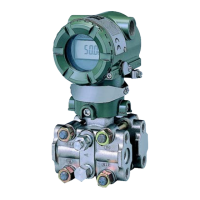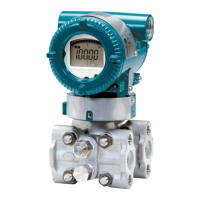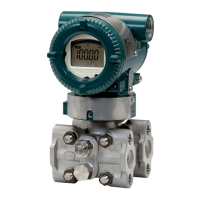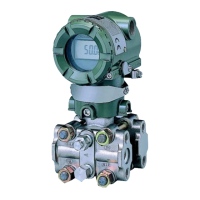<5. Installing Impulse Piping>
5-3
IM 01C25B01-01E
5.1.2 Routing the Impulse Piping
(1) Process Pressure Tap Angles
If condensate, gas, sediment or other extraneous
material in the process piping gets into the impulse
piping, pressure measurement errors may result. To
prevent such problems, the process pressure taps
mustbeangledasshowningure5.4accordingto
thekindofuidbeingmeasured.
NOTE
• Iftheprocessuidisagas,thetapsmustbe
vertical or within 45° either side of vertical.
• Iftheprocessuidisaliquid,thetapsmust
be horizontal or below horizontal, but not
more than 45° below horizontal.
• Iftheprocessuidissteamorother
condensing vapor, the taps must be
horizontal or above horizontal, but not more
than 45° above horizontal.
[Gas]
Pressure
taps
Process
piping
[Steam][Liquid]
45°
45°
45° 45°
45°
45°
F0504.ai
Figure 5.4 Process Pressure Tap Angle
(For Horizontal Piping)
(2) Position of Process Pressure Taps and
Transmitter
If condensate (or gas) accumulates in the impulse
piping, it should be removed periodically by
opening the drain (or vent) plugs. However, this will
generate a transient disturbance in the pressure
measurement, and therefore it is necessary to
position the taps and route the impulse piping so
that any extraneous liquid or gas generated in the
leadlines returns naturally to the process piping.
• Iftheprocessuidisagas,thenasarulethe
transmitter must be located higher than the
process pressure taps.
• Iftheprocessuidisaliquidorsteam,thenasa
rule the transmitter must be located lower than
the process pressure taps.
(3) Impulse Piping Slope
The impulse piping must be routed with only an
upward or downward slope. Even for horizontal
routing, the impulse piping should have a slope of
at least 1/10 to prevent condensate (or gases) from
accumulating in the pipes.
(4) Temperature Dierence Between Impulse
Lines (for dierential pressure transmitters)
Ifthereisatemperaturedierencebetweenthe
highandlowimpulselines,thedensitydierence
oftheuidsinthetwolineswillcauseanerrorin
themeasurementpressure.Whenmeasuringow,
impulse lines must be routed together so that there
isnotemperaturedierencebetweenthem.
(5) Condensate Pots for Steam Flow
Measurement (for dierential pressure
transmitters)
If the liquid in the impulse piping repeatedly
condenses or vaporizes as a result of changes
in the ambient or process temperature, this will
causeadierenceintheuidheadbetweenthe
high pressure and low pressure sides. To prevent
measurementerrorsduetotheseheaddierences,
condensate pots are used when measuring steam
ow.
(6) Preventing Wind Speed Eects in Very Low
Dierential Pressure Measurement
(for dierential pressure transmitters)
IMPORTANT
Whenusingadierentialpressuretransmitter
to measure very low pressures (draft pressure),
the low pressure connection port is left open
to atmospheric pressure (the reference
pressure).Anywindaroundthedierential
pressure transmitter will therefore cause errors
in the measurement. To prevent this, it will be
necessary either to enclose the transmitter in
a box, or to connect an impulse line to the low
pressure side and insert its end into a wind-
excluding pot (cylindrical with a base plate).

